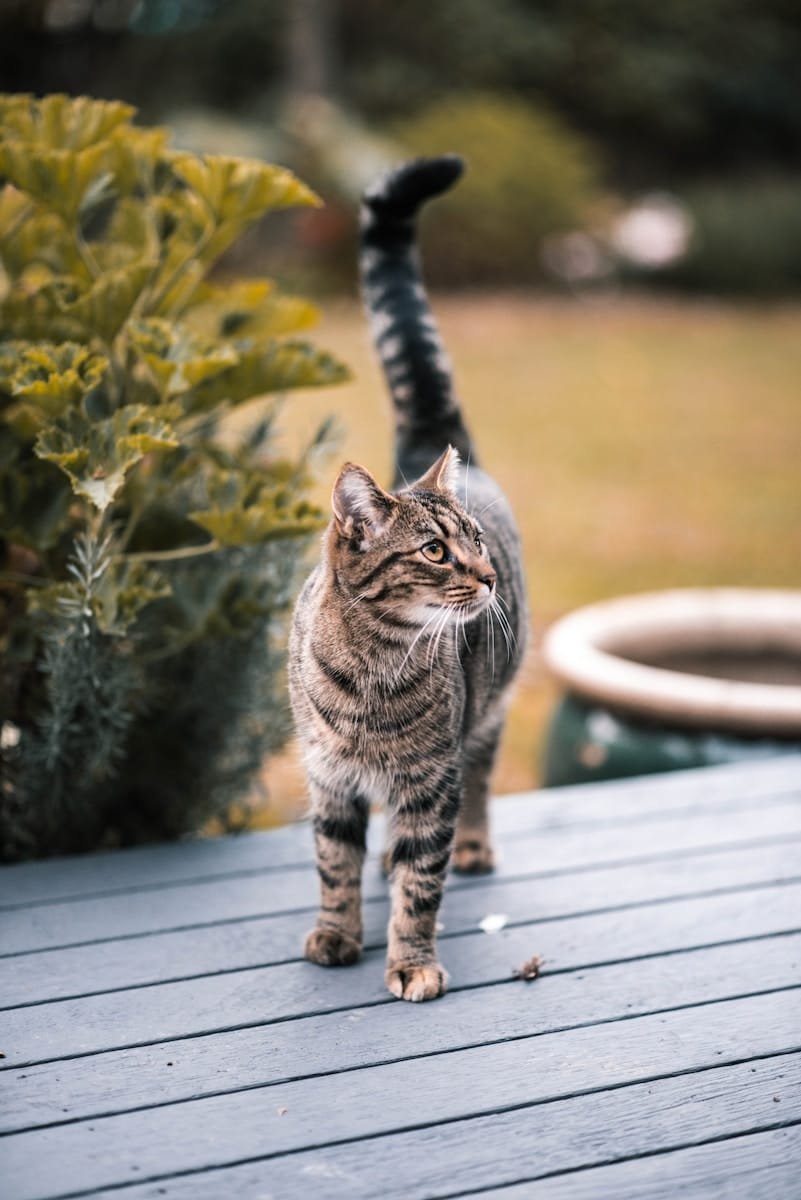Cat Wagging Tail While Sitting,Cats are fascinating creatures with a complex language of their own, often communicated through body language. One of the most intriguing behaviors in cats is tail wagging, especially when they are sitting. Unlike dogs, for whom tail wagging usually signifies happiness or excitement, cats use their tails to convey a myriad of emotions and intentions. This article aims to decode the mystery behind why cats wag their tails while sitting, helping cat owners better understand their feline friends.
The Anatomy of a Cat’s Tail
To fully appreciate the significance of tail wagging, it’s essential to understand the anatomy of a cat’s tail. A cat’s tail is an extension of its spine, consisting of 19 to 23 vertebrae enveloped in muscle, ligaments, and nerves. This intricate structure allows for a wide range of movements and provides critical functions, such as balance and communication.

Decoding Tail Wagging: What Does It Mean?
Tail wagging in cats can have different meanings depending on the context and the specific movement. Here are some of the most common reasons why cats wag their tails while sitting:
1. Concentration and Focus
When a cat is intensely focused on something, such as watching a bird outside the window or tracking a toy, its tail might wag or twitch. This is a sign of heightened concentration and predatory instincts. The tail movement is often subtle and rhythmic, reflecting the cat’s mental engagement with its target.
2. Irritation or Annoyance
A cat’s tail can serve as a barometer for its irritation levels. Rapid, forceful tail wagging or thumping against the floor while sitting often indicates annoyance or frustration. This could be a response to unwanted petting, another animal’s presence, or any other stimulus that the cat finds bothersome.
3. Conflict or Ambivalence
Sometimes, a cat might wag its tail while sitting because it is experiencing conflicting emotions. For instance, a cat may want to stay close to its owner but also feel uneasy about something in its environment. This ambivalence can result in a mix of signals, including tail wagging, as the cat tries to process its feelings.
4. Playfulness and Excitement
Although less common, some cats wag their tails when they are playful or excited. This behavior is more subtle compared to a dog’s wagging but can still indicate that the cat is in a good mood and ready to engage in play. The tail movements in this context are usually lighter and more fluid.
5. Pain or Discomfort
Tail wagging can sometimes be a sign that the cat is experiencing physical discomfort or pain. If your cat frequently wags its tail while sitting and shows other signs of distress, such as vocalizing or a change in behavior, it might be a good idea to consult a veterinarian to rule out any underlying health issues.
The Role of Context in Interpreting Tail Wagging
While tail wagging can provide valuable insights into a cat’s emotional state, it’s crucial to consider the broader context and other body language cues to make an accurate interpretation.
Combining Tail Signals with Other Body Language
- Ears: Forward-facing ears typically indicate interest or curiosity, while ears that are flattened or turned back suggest fear or aggression.
- Eyes: Dilated pupils can signify excitement, fear, or arousal, while constricted pupils might indicate aggression or focus.
- Whiskers: Whiskers that are pushed forward usually denote curiosity or interest, while whiskers pulled back against the face indicate fear or discomfort.
- Posture: A relaxed body posture suggests contentment, while a tense or crouched posture can signal anxiety or readiness to defend.
Environmental and Situational Factors
Understanding the environment and situation in which the tail wagging occurs is also essential. For example, a cat sitting near a window and wagging its tail might be focused on something outside, like a bird or squirrel. In contrast, a cat sitting next to a new pet or person might wag its tail due to anxiety or curiosity.
Practical Tips for Responding to Your Cat’s Tail Wagging
Once you’ve interpreted the reason behind your cat’s tail wagging, you can respond appropriately to meet its needs and improve its well-being.
1. Respect Their Space
If your cat is wagging its tail due to irritation or annoyance, it’s best to give it some space. Avoid petting or picking up your cat during these moments to prevent escalating its discomfort or stress.
2. Engage in Play
For cats wagging their tails out of playfulness or excitement, engaging them with toys and activities can be beneficial. Interactive toys, such as feather wands or laser pointers, can help channel their energy and strengthen your bond.
3. Monitor Health
If your cat’s tail wagging seems to be related to pain or discomfort, observe for other signs of illness and consult your veterinarian. Early detection and treatment of health issues can prevent more serious problems down the line.
4. Create a Safe Environment
Ensuring that your cat feels safe and secure in its environment can reduce stress and unwanted tail wagging. Provide hiding spots, climbing structures, and a consistent routine to help your cat feel more at ease.
Frequently Asked Questions About Cat Tail Wagging
Do all cats wag their tails when sitting?
Not all cats exhibit the same behaviors, and tail wagging while sitting can vary from one cat to another. Some cats may rarely wag their tails, while others do it more frequently based on their personality and experiences.
Can tail wagging indicate that my cat is happy?
While tail wagging in cats is not typically associated with happiness in the same way it is with dogs, some tail movements can indicate positive emotions like playfulness or excitement. Understanding the specific context and accompanying body language is key to interpreting your cat’s feelings.
Should I be concerned if my cat wags its tail frequently?
Frequent tail wagging is not necessarily a cause for concern unless it is accompanied by signs of distress, pain, or behavioral changes. If you notice any unusual behavior or suspect that your cat may be unwell, consulting a veterinarian is always a good idea.
Conclusion
Cats use their tails to communicate a wide range of emotions and intentions, and understanding these signals can greatly enhance your relationship with your feline friend. While cats do not wag their tails in the same way dogs do to show happiness, they do use tail movements to express various feelings, from concentration and playfulness to irritation and discomfort. By paying attention to the context and accompanying body language, you can accurately interpret your cat’s tail wagging and respond in ways that meet their needs and promote their well-being.
Remember, each cat is unique, and spending time observing and interacting with your cat will help you become more attuned to its individual communication style. By doing so, you can ensure a happier, healthier, and more harmonious relationship with your beloved pet.
Discover more from EMMOCEB
Subscribe to get the latest posts sent to your email.






